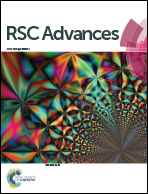Synthesis and structural characterization, by spectroscopic and computational methods, of two fluorescent 3-hydroxy-4-pyridinone chelators bearing sulphorhodamine B and naphthalene†
Abstract
Compounds MRB2 and MRB4 are part of a set of 3-hydroxy-4-pyridinone fluorescent chelators designed to be used as antimicrobial compounds. Their formulae and structures have been characterized by mass spectrometry, elemental analysis, nuclear magnetic resonance and X-ray crystallography. Identification of the most stable conformations of both compounds in an aqueous environment was achieved by molecular dynamics simulations. To the best of our knowledge, this is the first study in which: (a) a crystal structure of a rhodamine labelled 3-hydroxy-4-pyridinone chelator is reported and (b) a prediction of the range of conformations that these chelators may exhibit in solution is performed. The most frequent and energetically favoured geometries adopted by MRB2 and MRB4 have the chelating group facing the benzene and naphthalene groups of each compound, respectively. This molecular arrangement promotes the establishment of π–π interactions between both rings, which stabilize the overall conformations.


 Please wait while we load your content...
Please wait while we load your content...